Tax Implications for Foreign Investors in Australian Mining Industry
VerifiedAdded on 2022/08/26
|9
|2057
|20
Report
AI Summary
This report provides an in-depth analysis of Australian taxation law, particularly focusing on the tax implications for foreign investors within the mining industry. It begins by outlining the key differences in tax treatment between Australian and foreign residents, emphasizing the implications for foreign entities. The report delves into the relevant sections of the ITAA 1997, CGT, and the Foreign Acquisitions and Takeovers Regulation 2015, illustrating how these regulations impact foreign investment. A significant portion of the report is dedicated to the case of Glencore Investment Pty Ltd, highlighting the complexities of transfer pricing and the ATO's role in assessing arm's length transactions. Recommendations for tax reforms are also provided, including suggestions for strengthening the ATO's ability to scrutinize non-arm's length transactions and prevent multinational tax avoidance. The report concludes by emphasizing the need for reforms to ensure fair taxation and prevent foreign entities from exploiting loopholes in the current system. This report is a valuable resource for students studying Australian taxation law and those interested in the intersection of foreign investment and the mining industry.
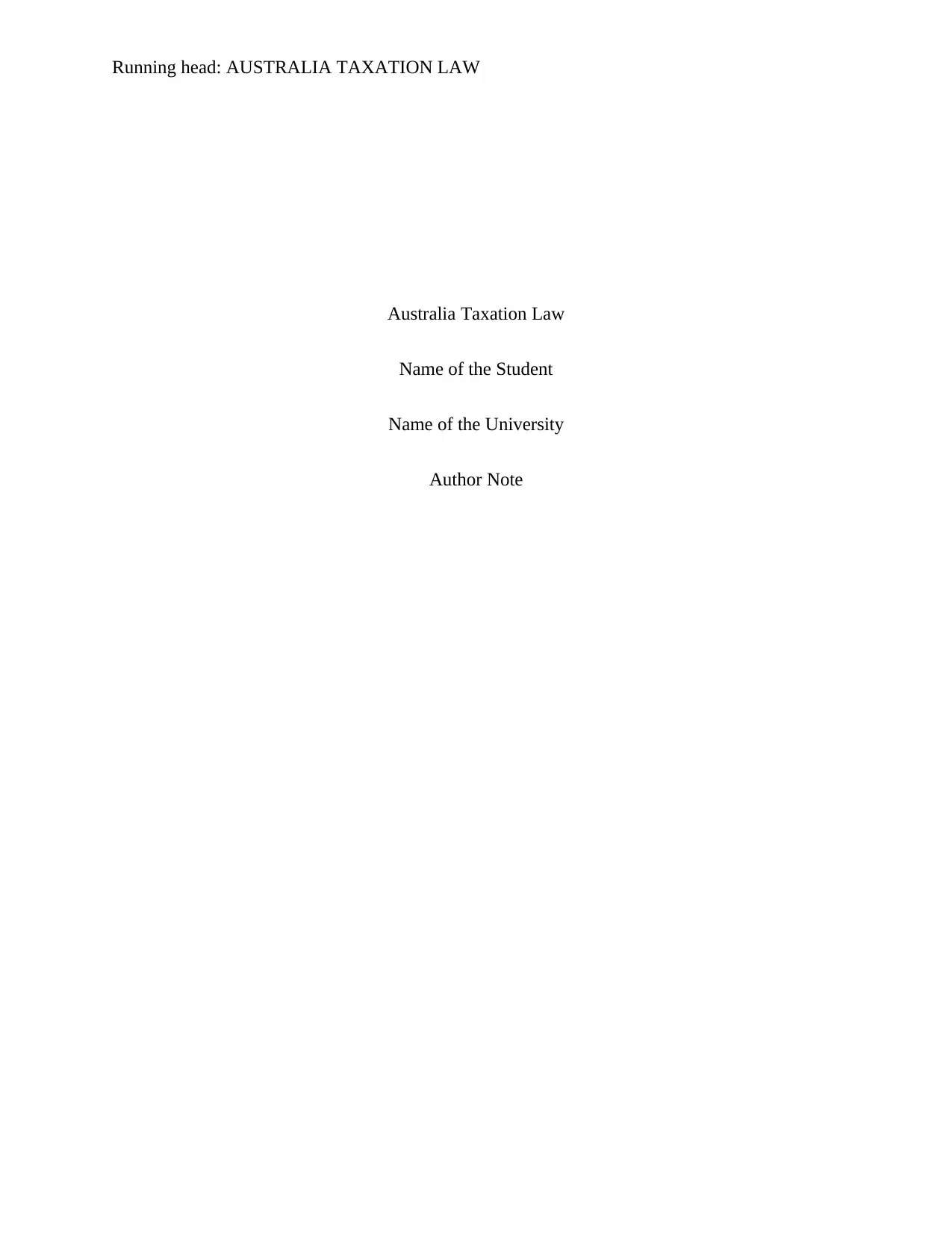
Running head: AUSTRALIA TAXATION LAW
Australia Taxation Law
Name of the Student
Name of the University
Author Note
Australia Taxation Law
Name of the Student
Name of the University
Author Note
Paraphrase This Document
Need a fresh take? Get an instant paraphrase of this document with our AI Paraphraser
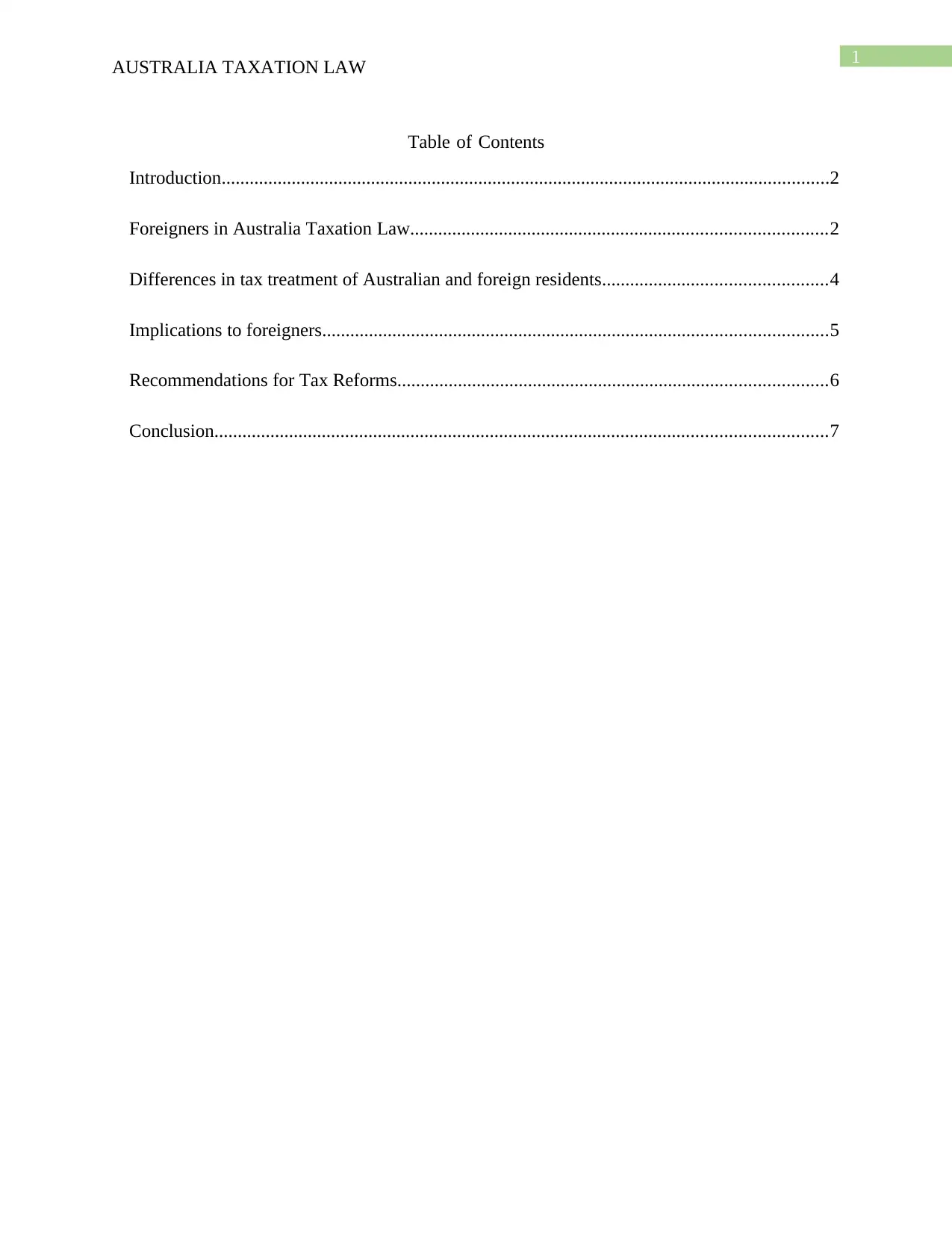
1
AUSTRALIA TAXATION LAW
Table of Contents
Introduction..................................................................................................................................2
Foreigners in Australia Taxation Law.........................................................................................2
Differences in tax treatment of Australian and foreign residents................................................4
Implications to foreigners............................................................................................................5
Recommendations for Tax Reforms............................................................................................6
Conclusion...................................................................................................................................7
AUSTRALIA TAXATION LAW
Table of Contents
Introduction..................................................................................................................................2
Foreigners in Australia Taxation Law.........................................................................................2
Differences in tax treatment of Australian and foreign residents................................................4
Implications to foreigners............................................................................................................5
Recommendations for Tax Reforms............................................................................................6
Conclusion...................................................................................................................................7
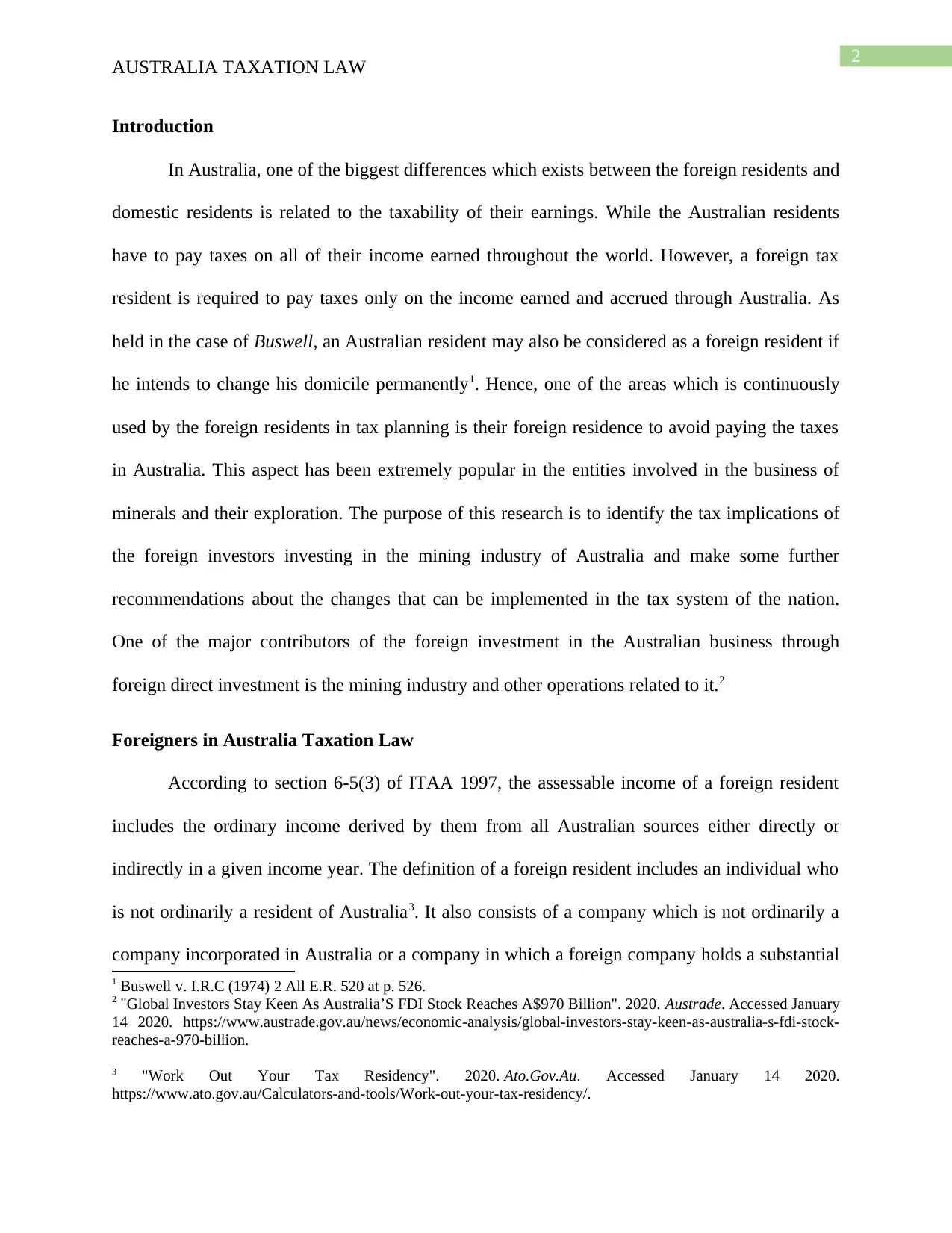
2
AUSTRALIA TAXATION LAW
Introduction
In Australia, one of the biggest differences which exists between the foreign residents and
domestic residents is related to the taxability of their earnings. While the Australian residents
have to pay taxes on all of their income earned throughout the world. However, a foreign tax
resident is required to pay taxes only on the income earned and accrued through Australia. As
held in the case of Buswell, an Australian resident may also be considered as a foreign resident if
he intends to change his domicile permanently1. Hence, one of the areas which is continuously
used by the foreign residents in tax planning is their foreign residence to avoid paying the taxes
in Australia. This aspect has been extremely popular in the entities involved in the business of
minerals and their exploration. The purpose of this research is to identify the tax implications of
the foreign investors investing in the mining industry of Australia and make some further
recommendations about the changes that can be implemented in the tax system of the nation.
One of the major contributors of the foreign investment in the Australian business through
foreign direct investment is the mining industry and other operations related to it.2
Foreigners in Australia Taxation Law
According to section 6-5(3) of ITAA 1997, the assessable income of a foreign resident
includes the ordinary income derived by them from all Australian sources either directly or
indirectly in a given income year. The definition of a foreign resident includes an individual who
is not ordinarily a resident of Australia3. It also consists of a company which is not ordinarily a
company incorporated in Australia or a company in which a foreign company holds a substantial
1 Buswell v. I.R.C (1974) 2 All E.R. 520 at p. 526.
2 "Global Investors Stay Keen As Australia’S FDI Stock Reaches A$970 Billion". 2020. Austrade. Accessed January
14 2020. https://www.austrade.gov.au/news/economic-analysis/global-investors-stay-keen-as-australia-s-fdi-stock-
reaches-a-970-billion.
3 "Work Out Your Tax Residency". 2020. Ato.Gov.Au. Accessed January 14 2020.
https://www.ato.gov.au/Calculators-and-tools/Work-out-your-tax-residency/.
AUSTRALIA TAXATION LAW
Introduction
In Australia, one of the biggest differences which exists between the foreign residents and
domestic residents is related to the taxability of their earnings. While the Australian residents
have to pay taxes on all of their income earned throughout the world. However, a foreign tax
resident is required to pay taxes only on the income earned and accrued through Australia. As
held in the case of Buswell, an Australian resident may also be considered as a foreign resident if
he intends to change his domicile permanently1. Hence, one of the areas which is continuously
used by the foreign residents in tax planning is their foreign residence to avoid paying the taxes
in Australia. This aspect has been extremely popular in the entities involved in the business of
minerals and their exploration. The purpose of this research is to identify the tax implications of
the foreign investors investing in the mining industry of Australia and make some further
recommendations about the changes that can be implemented in the tax system of the nation.
One of the major contributors of the foreign investment in the Australian business through
foreign direct investment is the mining industry and other operations related to it.2
Foreigners in Australia Taxation Law
According to section 6-5(3) of ITAA 1997, the assessable income of a foreign resident
includes the ordinary income derived by them from all Australian sources either directly or
indirectly in a given income year. The definition of a foreign resident includes an individual who
is not ordinarily a resident of Australia3. It also consists of a company which is not ordinarily a
company incorporated in Australia or a company in which a foreign company holds a substantial
1 Buswell v. I.R.C (1974) 2 All E.R. 520 at p. 526.
2 "Global Investors Stay Keen As Australia’S FDI Stock Reaches A$970 Billion". 2020. Austrade. Accessed January
14 2020. https://www.austrade.gov.au/news/economic-analysis/global-investors-stay-keen-as-australia-s-fdi-stock-
reaches-a-970-billion.
3 "Work Out Your Tax Residency". 2020. Ato.Gov.Au. Accessed January 14 2020.
https://www.ato.gov.au/Calculators-and-tools/Work-out-your-tax-residency/.
⊘ This is a preview!⊘
Do you want full access?
Subscribe today to unlock all pages.

Trusted by 1+ million students worldwide
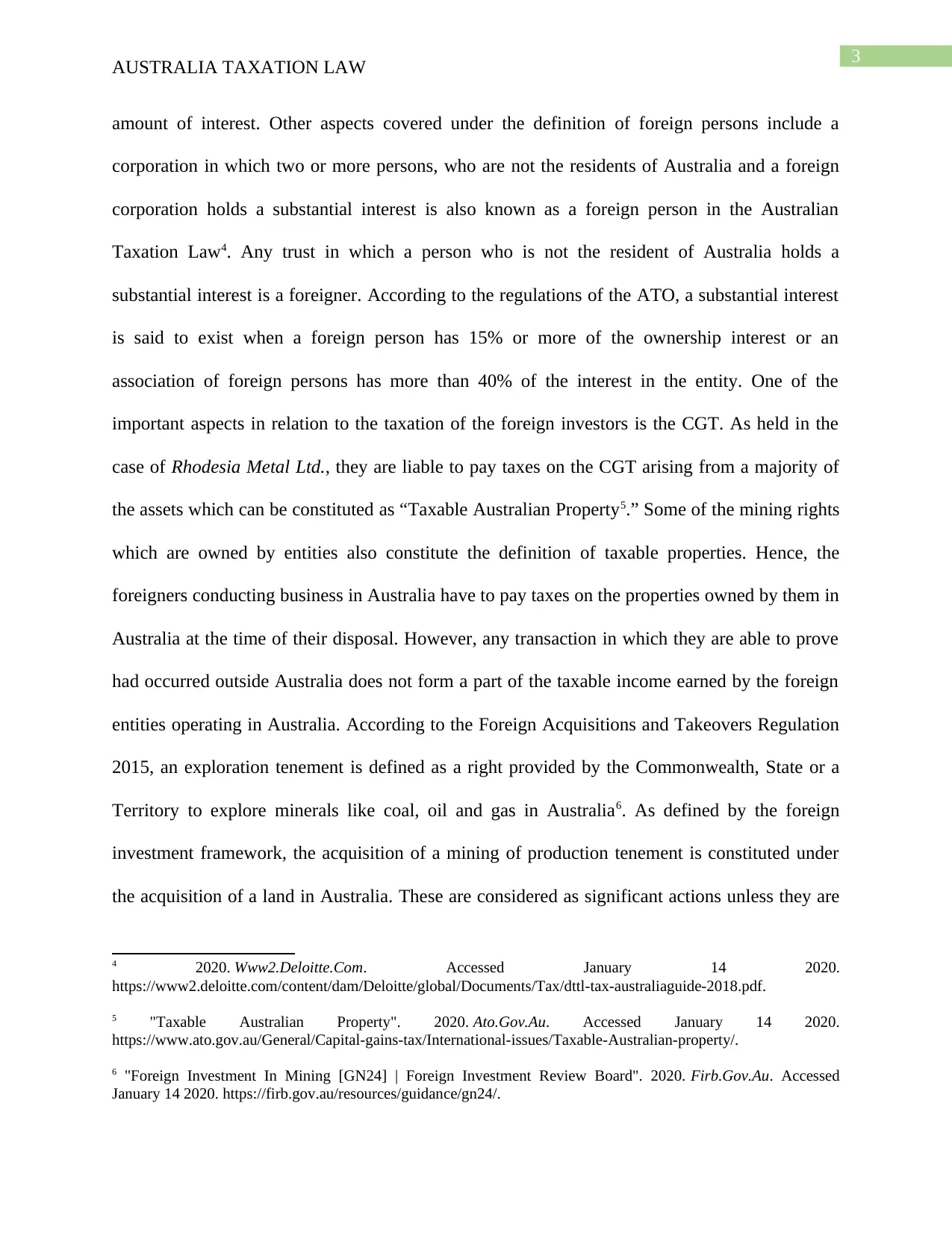
3
AUSTRALIA TAXATION LAW
amount of interest. Other aspects covered under the definition of foreign persons include a
corporation in which two or more persons, who are not the residents of Australia and a foreign
corporation holds a substantial interest is also known as a foreign person in the Australian
Taxation Law4. Any trust in which a person who is not the resident of Australia holds a
substantial interest is a foreigner. According to the regulations of the ATO, a substantial interest
is said to exist when a foreign person has 15% or more of the ownership interest or an
association of foreign persons has more than 40% of the interest in the entity. One of the
important aspects in relation to the taxation of the foreign investors is the CGT. As held in the
case of Rhodesia Metal Ltd., they are liable to pay taxes on the CGT arising from a majority of
the assets which can be constituted as “Taxable Australian Property5.” Some of the mining rights
which are owned by entities also constitute the definition of taxable properties. Hence, the
foreigners conducting business in Australia have to pay taxes on the properties owned by them in
Australia at the time of their disposal. However, any transaction in which they are able to prove
had occurred outside Australia does not form a part of the taxable income earned by the foreign
entities operating in Australia. According to the Foreign Acquisitions and Takeovers Regulation
2015, an exploration tenement is defined as a right provided by the Commonwealth, State or a
Territory to explore minerals like coal, oil and gas in Australia6. As defined by the foreign
investment framework, the acquisition of a mining of production tenement is constituted under
the acquisition of a land in Australia. These are considered as significant actions unless they are
4 2020. Www2.Deloitte.Com. Accessed January 14 2020.
https://www2.deloitte.com/content/dam/Deloitte/global/Documents/Tax/dttl-tax-australiaguide-2018.pdf.
5 "Taxable Australian Property". 2020. Ato.Gov.Au. Accessed January 14 2020.
https://www.ato.gov.au/General/Capital-gains-tax/International-issues/Taxable-Australian-property/.
6 "Foreign Investment In Mining [GN24] | Foreign Investment Review Board". 2020. Firb.Gov.Au. Accessed
January 14 2020. https://firb.gov.au/resources/guidance/gn24/.
AUSTRALIA TAXATION LAW
amount of interest. Other aspects covered under the definition of foreign persons include a
corporation in which two or more persons, who are not the residents of Australia and a foreign
corporation holds a substantial interest is also known as a foreign person in the Australian
Taxation Law4. Any trust in which a person who is not the resident of Australia holds a
substantial interest is a foreigner. According to the regulations of the ATO, a substantial interest
is said to exist when a foreign person has 15% or more of the ownership interest or an
association of foreign persons has more than 40% of the interest in the entity. One of the
important aspects in relation to the taxation of the foreign investors is the CGT. As held in the
case of Rhodesia Metal Ltd., they are liable to pay taxes on the CGT arising from a majority of
the assets which can be constituted as “Taxable Australian Property5.” Some of the mining rights
which are owned by entities also constitute the definition of taxable properties. Hence, the
foreigners conducting business in Australia have to pay taxes on the properties owned by them in
Australia at the time of their disposal. However, any transaction in which they are able to prove
had occurred outside Australia does not form a part of the taxable income earned by the foreign
entities operating in Australia. According to the Foreign Acquisitions and Takeovers Regulation
2015, an exploration tenement is defined as a right provided by the Commonwealth, State or a
Territory to explore minerals like coal, oil and gas in Australia6. As defined by the foreign
investment framework, the acquisition of a mining of production tenement is constituted under
the acquisition of a land in Australia. These are considered as significant actions unless they are
4 2020. Www2.Deloitte.Com. Accessed January 14 2020.
https://www2.deloitte.com/content/dam/Deloitte/global/Documents/Tax/dttl-tax-australiaguide-2018.pdf.
5 "Taxable Australian Property". 2020. Ato.Gov.Au. Accessed January 14 2020.
https://www.ato.gov.au/General/Capital-gains-tax/International-issues/Taxable-Australian-property/.
6 "Foreign Investment In Mining [GN24] | Foreign Investment Review Board". 2020. Firb.Gov.Au. Accessed
January 14 2020. https://firb.gov.au/resources/guidance/gn24/.
Paraphrase This Document
Need a fresh take? Get an instant paraphrase of this document with our AI Paraphraser
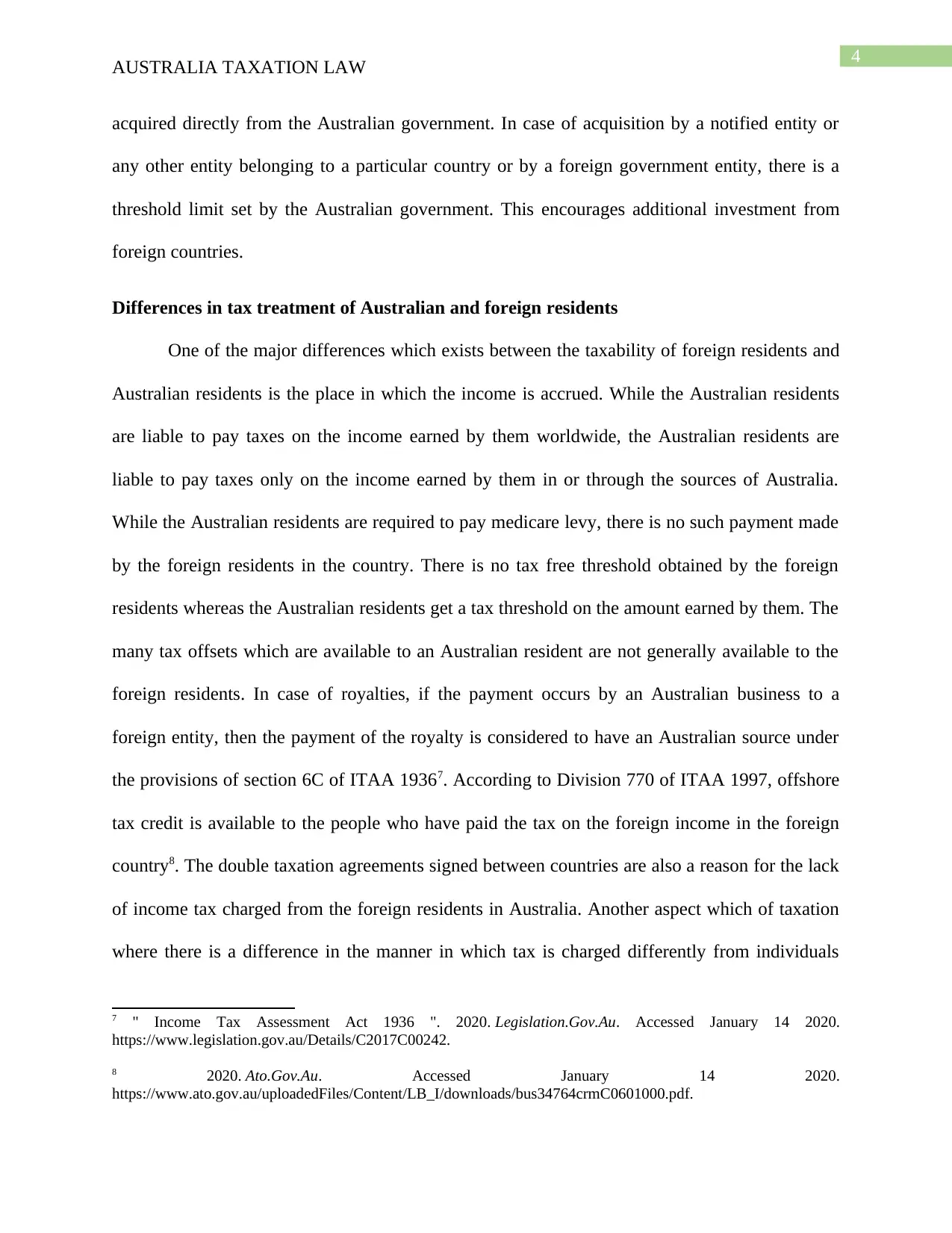
4
AUSTRALIA TAXATION LAW
acquired directly from the Australian government. In case of acquisition by a notified entity or
any other entity belonging to a particular country or by a foreign government entity, there is a
threshold limit set by the Australian government. This encourages additional investment from
foreign countries.
Differences in tax treatment of Australian and foreign residents
One of the major differences which exists between the taxability of foreign residents and
Australian residents is the place in which the income is accrued. While the Australian residents
are liable to pay taxes on the income earned by them worldwide, the Australian residents are
liable to pay taxes only on the income earned by them in or through the sources of Australia.
While the Australian residents are required to pay medicare levy, there is no such payment made
by the foreign residents in the country. There is no tax free threshold obtained by the foreign
residents whereas the Australian residents get a tax threshold on the amount earned by them. The
many tax offsets which are available to an Australian resident are not generally available to the
foreign residents. In case of royalties, if the payment occurs by an Australian business to a
foreign entity, then the payment of the royalty is considered to have an Australian source under
the provisions of section 6C of ITAA 19367. According to Division 770 of ITAA 1997, offshore
tax credit is available to the people who have paid the tax on the foreign income in the foreign
country8. The double taxation agreements signed between countries are also a reason for the lack
of income tax charged from the foreign residents in Australia. Another aspect which of taxation
where there is a difference in the manner in which tax is charged differently from individuals
7 " Income Tax Assessment Act 1936 ". 2020. Legislation.Gov.Au. Accessed January 14 2020.
https://www.legislation.gov.au/Details/C2017C00242.
8 2020. Ato.Gov.Au. Accessed January 14 2020.
https://www.ato.gov.au/uploadedFiles/Content/LB_I/downloads/bus34764crmC0601000.pdf.
AUSTRALIA TAXATION LAW
acquired directly from the Australian government. In case of acquisition by a notified entity or
any other entity belonging to a particular country or by a foreign government entity, there is a
threshold limit set by the Australian government. This encourages additional investment from
foreign countries.
Differences in tax treatment of Australian and foreign residents
One of the major differences which exists between the taxability of foreign residents and
Australian residents is the place in which the income is accrued. While the Australian residents
are liable to pay taxes on the income earned by them worldwide, the Australian residents are
liable to pay taxes only on the income earned by them in or through the sources of Australia.
While the Australian residents are required to pay medicare levy, there is no such payment made
by the foreign residents in the country. There is no tax free threshold obtained by the foreign
residents whereas the Australian residents get a tax threshold on the amount earned by them. The
many tax offsets which are available to an Australian resident are not generally available to the
foreign residents. In case of royalties, if the payment occurs by an Australian business to a
foreign entity, then the payment of the royalty is considered to have an Australian source under
the provisions of section 6C of ITAA 19367. According to Division 770 of ITAA 1997, offshore
tax credit is available to the people who have paid the tax on the foreign income in the foreign
country8. The double taxation agreements signed between countries are also a reason for the lack
of income tax charged from the foreign residents in Australia. Another aspect which of taxation
where there is a difference in the manner in which tax is charged differently from individuals
7 " Income Tax Assessment Act 1936 ". 2020. Legislation.Gov.Au. Accessed January 14 2020.
https://www.legislation.gov.au/Details/C2017C00242.
8 2020. Ato.Gov.Au. Accessed January 14 2020.
https://www.ato.gov.au/uploadedFiles/Content/LB_I/downloads/bus34764crmC0601000.pdf.
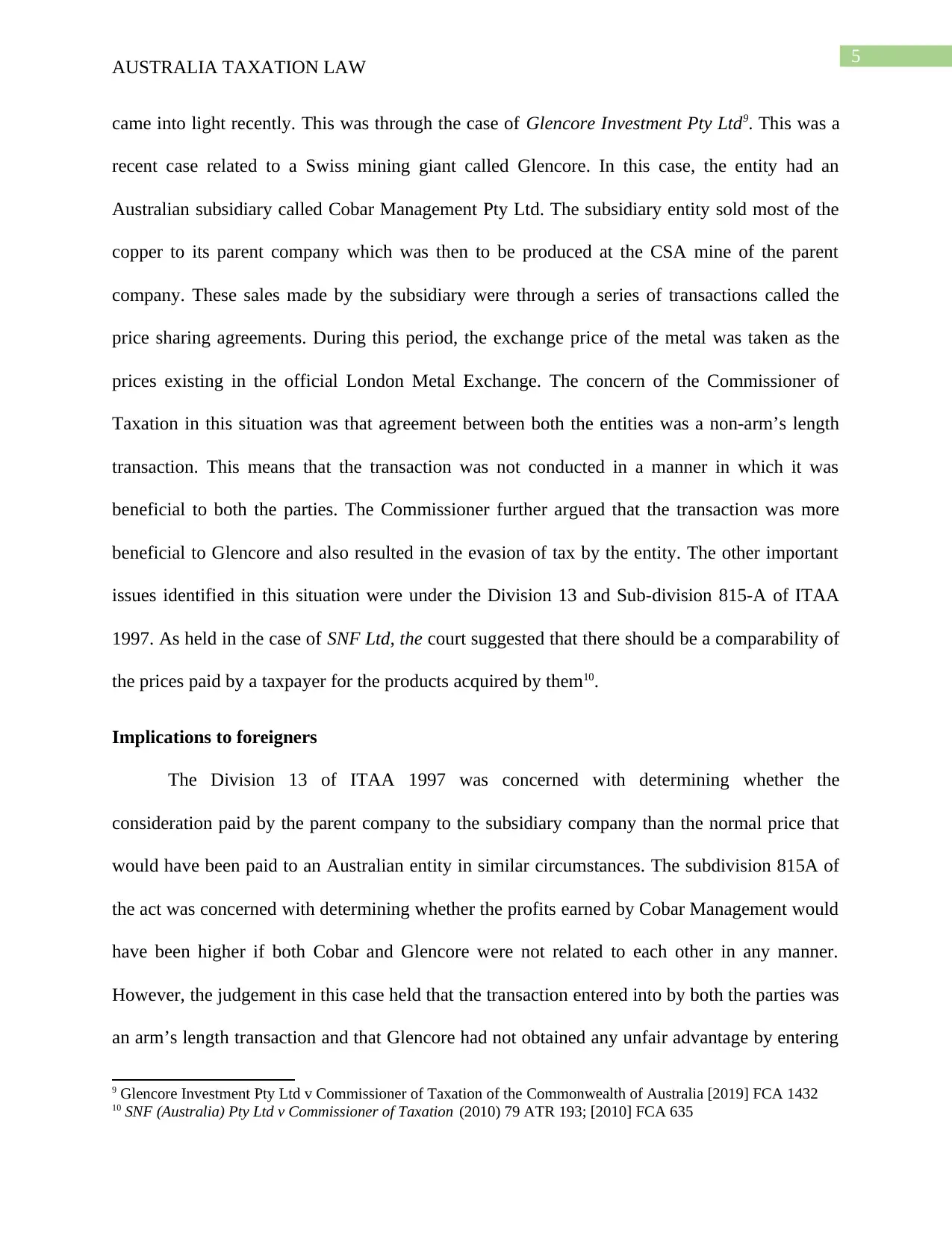
5
AUSTRALIA TAXATION LAW
came into light recently. This was through the case of Glencore Investment Pty Ltd9. This was a
recent case related to a Swiss mining giant called Glencore. In this case, the entity had an
Australian subsidiary called Cobar Management Pty Ltd. The subsidiary entity sold most of the
copper to its parent company which was then to be produced at the CSA mine of the parent
company. These sales made by the subsidiary were through a series of transactions called the
price sharing agreements. During this period, the exchange price of the metal was taken as the
prices existing in the official London Metal Exchange. The concern of the Commissioner of
Taxation in this situation was that agreement between both the entities was a non-arm’s length
transaction. This means that the transaction was not conducted in a manner in which it was
beneficial to both the parties. The Commissioner further argued that the transaction was more
beneficial to Glencore and also resulted in the evasion of tax by the entity. The other important
issues identified in this situation were under the Division 13 and Sub-division 815-A of ITAA
1997. As held in the case of SNF Ltd, the court suggested that there should be a comparability of
the prices paid by a taxpayer for the products acquired by them10.
Implications to foreigners
The Division 13 of ITAA 1997 was concerned with determining whether the
consideration paid by the parent company to the subsidiary company than the normal price that
would have been paid to an Australian entity in similar circumstances. The subdivision 815A of
the act was concerned with determining whether the profits earned by Cobar Management would
have been higher if both Cobar and Glencore were not related to each other in any manner.
However, the judgement in this case held that the transaction entered into by both the parties was
an arm’s length transaction and that Glencore had not obtained any unfair advantage by entering
9 Glencore Investment Pty Ltd v Commissioner of Taxation of the Commonwealth of Australia [2019] FCA 1432
10 SNF (Australia) Pty Ltd v Commissioner of Taxation (2010) 79 ATR 193; [2010] FCA 635
AUSTRALIA TAXATION LAW
came into light recently. This was through the case of Glencore Investment Pty Ltd9. This was a
recent case related to a Swiss mining giant called Glencore. In this case, the entity had an
Australian subsidiary called Cobar Management Pty Ltd. The subsidiary entity sold most of the
copper to its parent company which was then to be produced at the CSA mine of the parent
company. These sales made by the subsidiary were through a series of transactions called the
price sharing agreements. During this period, the exchange price of the metal was taken as the
prices existing in the official London Metal Exchange. The concern of the Commissioner of
Taxation in this situation was that agreement between both the entities was a non-arm’s length
transaction. This means that the transaction was not conducted in a manner in which it was
beneficial to both the parties. The Commissioner further argued that the transaction was more
beneficial to Glencore and also resulted in the evasion of tax by the entity. The other important
issues identified in this situation were under the Division 13 and Sub-division 815-A of ITAA
1997. As held in the case of SNF Ltd, the court suggested that there should be a comparability of
the prices paid by a taxpayer for the products acquired by them10.
Implications to foreigners
The Division 13 of ITAA 1997 was concerned with determining whether the
consideration paid by the parent company to the subsidiary company than the normal price that
would have been paid to an Australian entity in similar circumstances. The subdivision 815A of
the act was concerned with determining whether the profits earned by Cobar Management would
have been higher if both Cobar and Glencore were not related to each other in any manner.
However, the judgement in this case held that the transaction entered into by both the parties was
an arm’s length transaction and that Glencore had not obtained any unfair advantage by entering
9 Glencore Investment Pty Ltd v Commissioner of Taxation of the Commonwealth of Australia [2019] FCA 1432
10 SNF (Australia) Pty Ltd v Commissioner of Taxation (2010) 79 ATR 193; [2010] FCA 635
⊘ This is a preview!⊘
Do you want full access?
Subscribe today to unlock all pages.

Trusted by 1+ million students worldwide
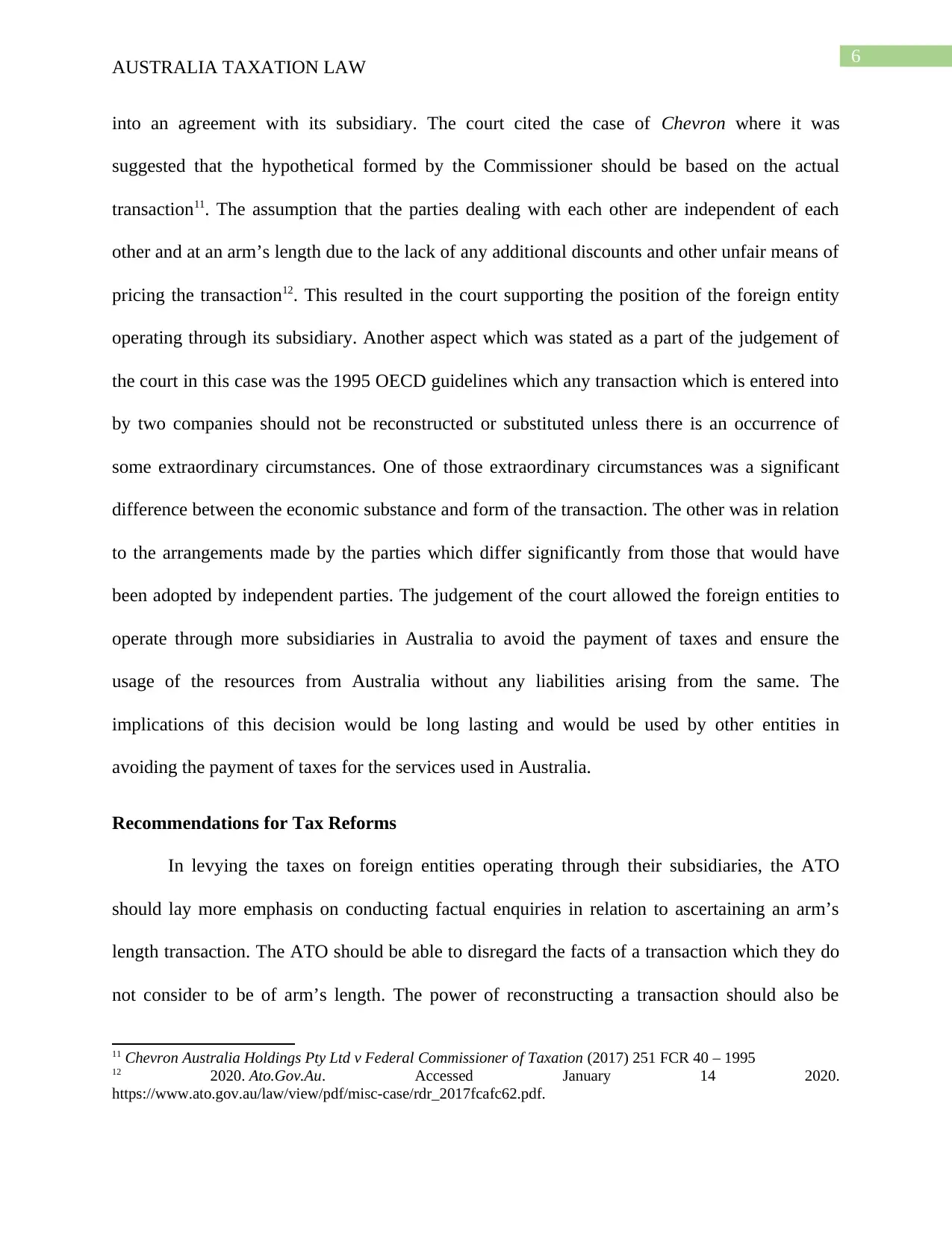
6
AUSTRALIA TAXATION LAW
into an agreement with its subsidiary. The court cited the case of Chevron where it was
suggested that the hypothetical formed by the Commissioner should be based on the actual
transaction11. The assumption that the parties dealing with each other are independent of each
other and at an arm’s length due to the lack of any additional discounts and other unfair means of
pricing the transaction12. This resulted in the court supporting the position of the foreign entity
operating through its subsidiary. Another aspect which was stated as a part of the judgement of
the court in this case was the 1995 OECD guidelines which any transaction which is entered into
by two companies should not be reconstructed or substituted unless there is an occurrence of
some extraordinary circumstances. One of those extraordinary circumstances was a significant
difference between the economic substance and form of the transaction. The other was in relation
to the arrangements made by the parties which differ significantly from those that would have
been adopted by independent parties. The judgement of the court allowed the foreign entities to
operate through more subsidiaries in Australia to avoid the payment of taxes and ensure the
usage of the resources from Australia without any liabilities arising from the same. The
implications of this decision would be long lasting and would be used by other entities in
avoiding the payment of taxes for the services used in Australia.
Recommendations for Tax Reforms
In levying the taxes on foreign entities operating through their subsidiaries, the ATO
should lay more emphasis on conducting factual enquiries in relation to ascertaining an arm’s
length transaction. The ATO should be able to disregard the facts of a transaction which they do
not consider to be of arm’s length. The power of reconstructing a transaction should also be
11 Chevron Australia Holdings Pty Ltd v Federal Commissioner of Taxation (2017) 251 FCR 40 – 1995
12 2020. Ato.Gov.Au. Accessed January 14 2020.
https://www.ato.gov.au/law/view/pdf/misc-case/rdr_2017fcafc62.pdf.
AUSTRALIA TAXATION LAW
into an agreement with its subsidiary. The court cited the case of Chevron where it was
suggested that the hypothetical formed by the Commissioner should be based on the actual
transaction11. The assumption that the parties dealing with each other are independent of each
other and at an arm’s length due to the lack of any additional discounts and other unfair means of
pricing the transaction12. This resulted in the court supporting the position of the foreign entity
operating through its subsidiary. Another aspect which was stated as a part of the judgement of
the court in this case was the 1995 OECD guidelines which any transaction which is entered into
by two companies should not be reconstructed or substituted unless there is an occurrence of
some extraordinary circumstances. One of those extraordinary circumstances was a significant
difference between the economic substance and form of the transaction. The other was in relation
to the arrangements made by the parties which differ significantly from those that would have
been adopted by independent parties. The judgement of the court allowed the foreign entities to
operate through more subsidiaries in Australia to avoid the payment of taxes and ensure the
usage of the resources from Australia without any liabilities arising from the same. The
implications of this decision would be long lasting and would be used by other entities in
avoiding the payment of taxes for the services used in Australia.
Recommendations for Tax Reforms
In levying the taxes on foreign entities operating through their subsidiaries, the ATO
should lay more emphasis on conducting factual enquiries in relation to ascertaining an arm’s
length transaction. The ATO should be able to disregard the facts of a transaction which they do
not consider to be of arm’s length. The power of reconstructing a transaction should also be
11 Chevron Australia Holdings Pty Ltd v Federal Commissioner of Taxation (2017) 251 FCR 40 – 1995
12 2020. Ato.Gov.Au. Accessed January 14 2020.
https://www.ato.gov.au/law/view/pdf/misc-case/rdr_2017fcafc62.pdf.
Paraphrase This Document
Need a fresh take? Get an instant paraphrase of this document with our AI Paraphraser
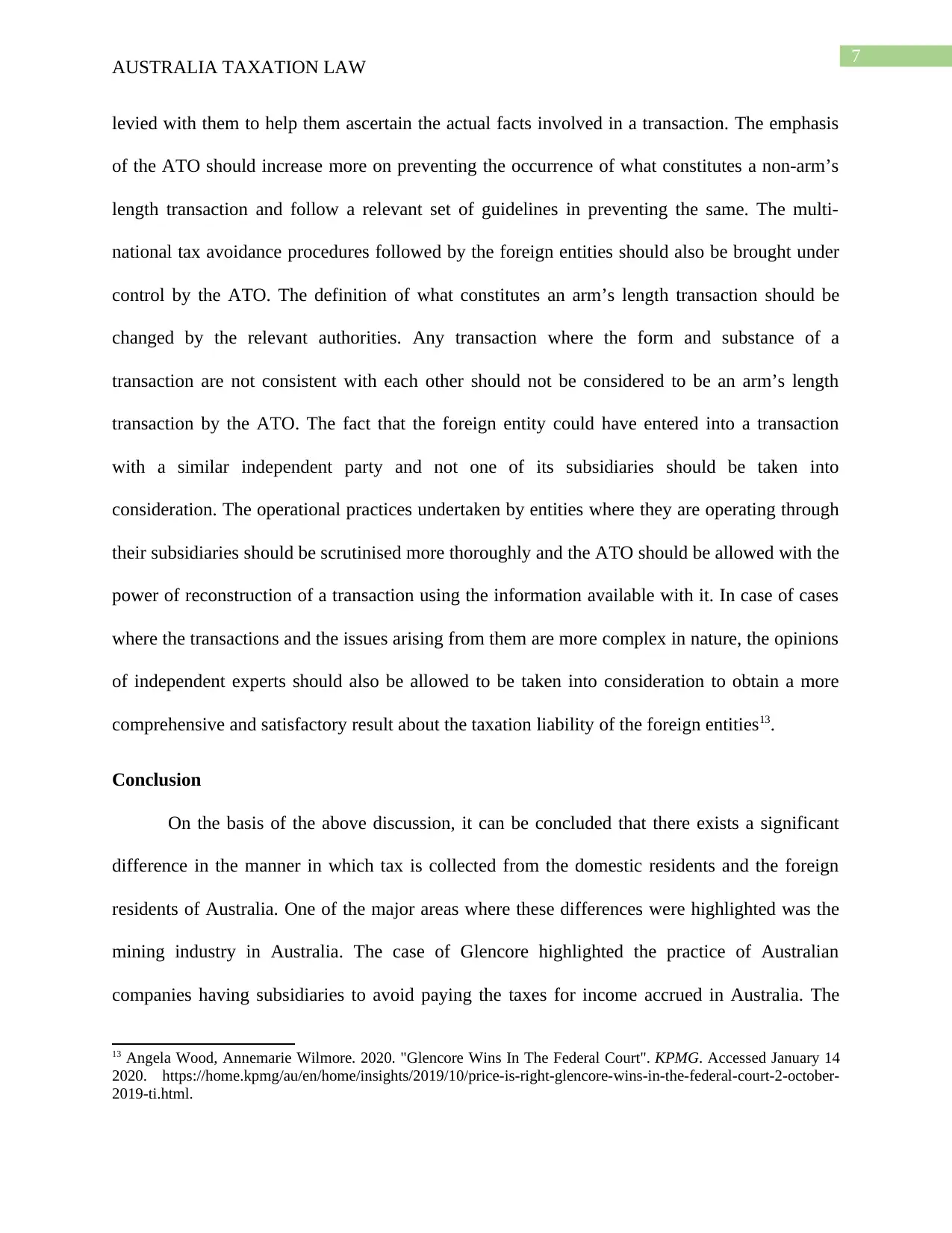
7
AUSTRALIA TAXATION LAW
levied with them to help them ascertain the actual facts involved in a transaction. The emphasis
of the ATO should increase more on preventing the occurrence of what constitutes a non-arm’s
length transaction and follow a relevant set of guidelines in preventing the same. The multi-
national tax avoidance procedures followed by the foreign entities should also be brought under
control by the ATO. The definition of what constitutes an arm’s length transaction should be
changed by the relevant authorities. Any transaction where the form and substance of a
transaction are not consistent with each other should not be considered to be an arm’s length
transaction by the ATO. The fact that the foreign entity could have entered into a transaction
with a similar independent party and not one of its subsidiaries should be taken into
consideration. The operational practices undertaken by entities where they are operating through
their subsidiaries should be scrutinised more thoroughly and the ATO should be allowed with the
power of reconstruction of a transaction using the information available with it. In case of cases
where the transactions and the issues arising from them are more complex in nature, the opinions
of independent experts should also be allowed to be taken into consideration to obtain a more
comprehensive and satisfactory result about the taxation liability of the foreign entities13.
Conclusion
On the basis of the above discussion, it can be concluded that there exists a significant
difference in the manner in which tax is collected from the domestic residents and the foreign
residents of Australia. One of the major areas where these differences were highlighted was the
mining industry in Australia. The case of Glencore highlighted the practice of Australian
companies having subsidiaries to avoid paying the taxes for income accrued in Australia. The
13 Angela Wood, Annemarie Wilmore. 2020. "Glencore Wins In The Federal Court". KPMG. Accessed January 14
2020. https://home.kpmg/au/en/home/insights/2019/10/price-is-right-glencore-wins-in-the-federal-court-2-october-
2019-ti.html.
AUSTRALIA TAXATION LAW
levied with them to help them ascertain the actual facts involved in a transaction. The emphasis
of the ATO should increase more on preventing the occurrence of what constitutes a non-arm’s
length transaction and follow a relevant set of guidelines in preventing the same. The multi-
national tax avoidance procedures followed by the foreign entities should also be brought under
control by the ATO. The definition of what constitutes an arm’s length transaction should be
changed by the relevant authorities. Any transaction where the form and substance of a
transaction are not consistent with each other should not be considered to be an arm’s length
transaction by the ATO. The fact that the foreign entity could have entered into a transaction
with a similar independent party and not one of its subsidiaries should be taken into
consideration. The operational practices undertaken by entities where they are operating through
their subsidiaries should be scrutinised more thoroughly and the ATO should be allowed with the
power of reconstruction of a transaction using the information available with it. In case of cases
where the transactions and the issues arising from them are more complex in nature, the opinions
of independent experts should also be allowed to be taken into consideration to obtain a more
comprehensive and satisfactory result about the taxation liability of the foreign entities13.
Conclusion
On the basis of the above discussion, it can be concluded that there exists a significant
difference in the manner in which tax is collected from the domestic residents and the foreign
residents of Australia. One of the major areas where these differences were highlighted was the
mining industry in Australia. The case of Glencore highlighted the practice of Australian
companies having subsidiaries to avoid paying the taxes for income accrued in Australia. The
13 Angela Wood, Annemarie Wilmore. 2020. "Glencore Wins In The Federal Court". KPMG. Accessed January 14
2020. https://home.kpmg/au/en/home/insights/2019/10/price-is-right-glencore-wins-in-the-federal-court-2-october-
2019-ti.html.
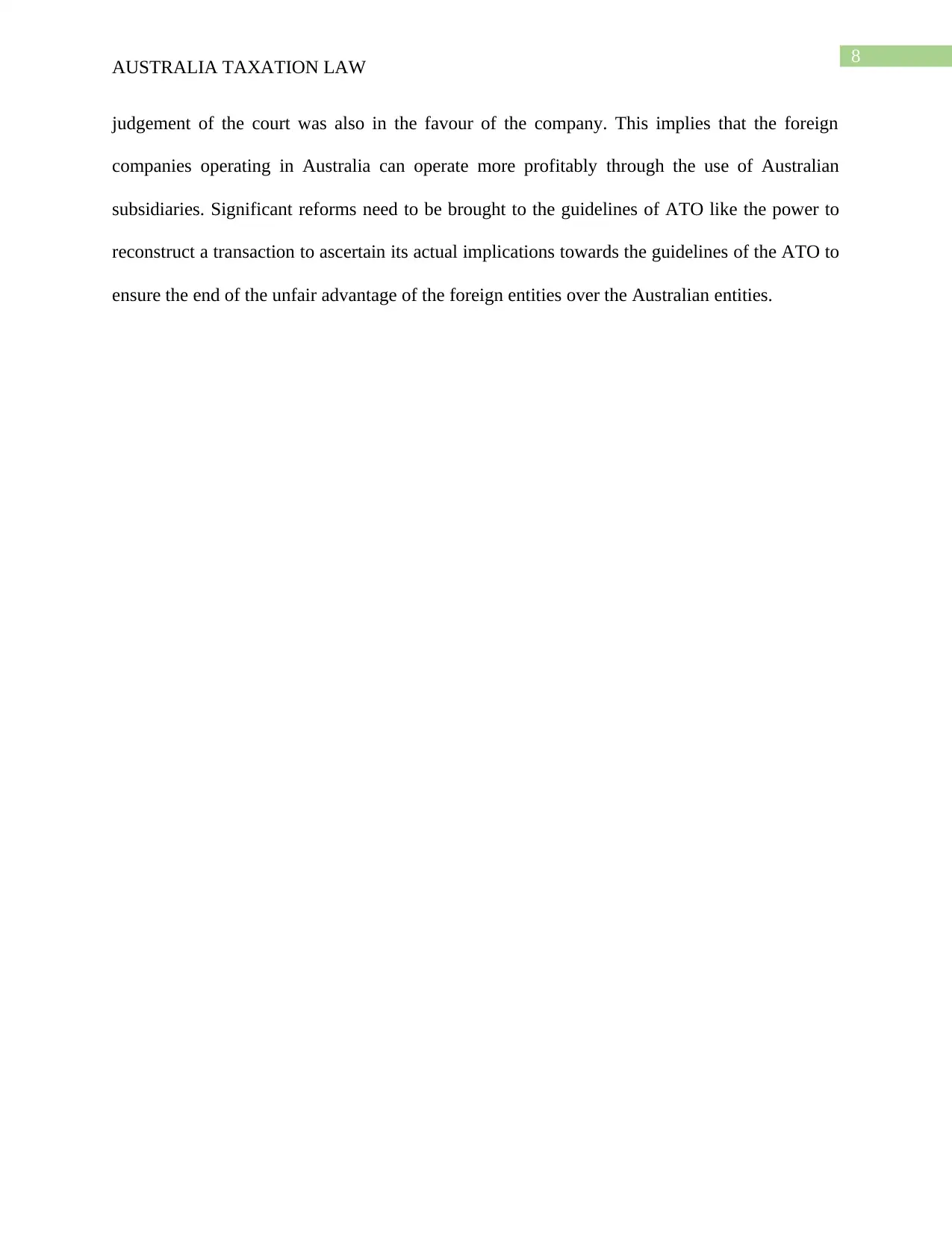
8
AUSTRALIA TAXATION LAW
judgement of the court was also in the favour of the company. This implies that the foreign
companies operating in Australia can operate more profitably through the use of Australian
subsidiaries. Significant reforms need to be brought to the guidelines of ATO like the power to
reconstruct a transaction to ascertain its actual implications towards the guidelines of the ATO to
ensure the end of the unfair advantage of the foreign entities over the Australian entities.
AUSTRALIA TAXATION LAW
judgement of the court was also in the favour of the company. This implies that the foreign
companies operating in Australia can operate more profitably through the use of Australian
subsidiaries. Significant reforms need to be brought to the guidelines of ATO like the power to
reconstruct a transaction to ascertain its actual implications towards the guidelines of the ATO to
ensure the end of the unfair advantage of the foreign entities over the Australian entities.
⊘ This is a preview!⊘
Do you want full access?
Subscribe today to unlock all pages.

Trusted by 1+ million students worldwide
1 out of 9
Related Documents
Your All-in-One AI-Powered Toolkit for Academic Success.
+13062052269
info@desklib.com
Available 24*7 on WhatsApp / Email
![[object Object]](/_next/static/media/star-bottom.7253800d.svg)
Unlock your academic potential
Copyright © 2020–2025 A2Z Services. All Rights Reserved. Developed and managed by ZUCOL.





